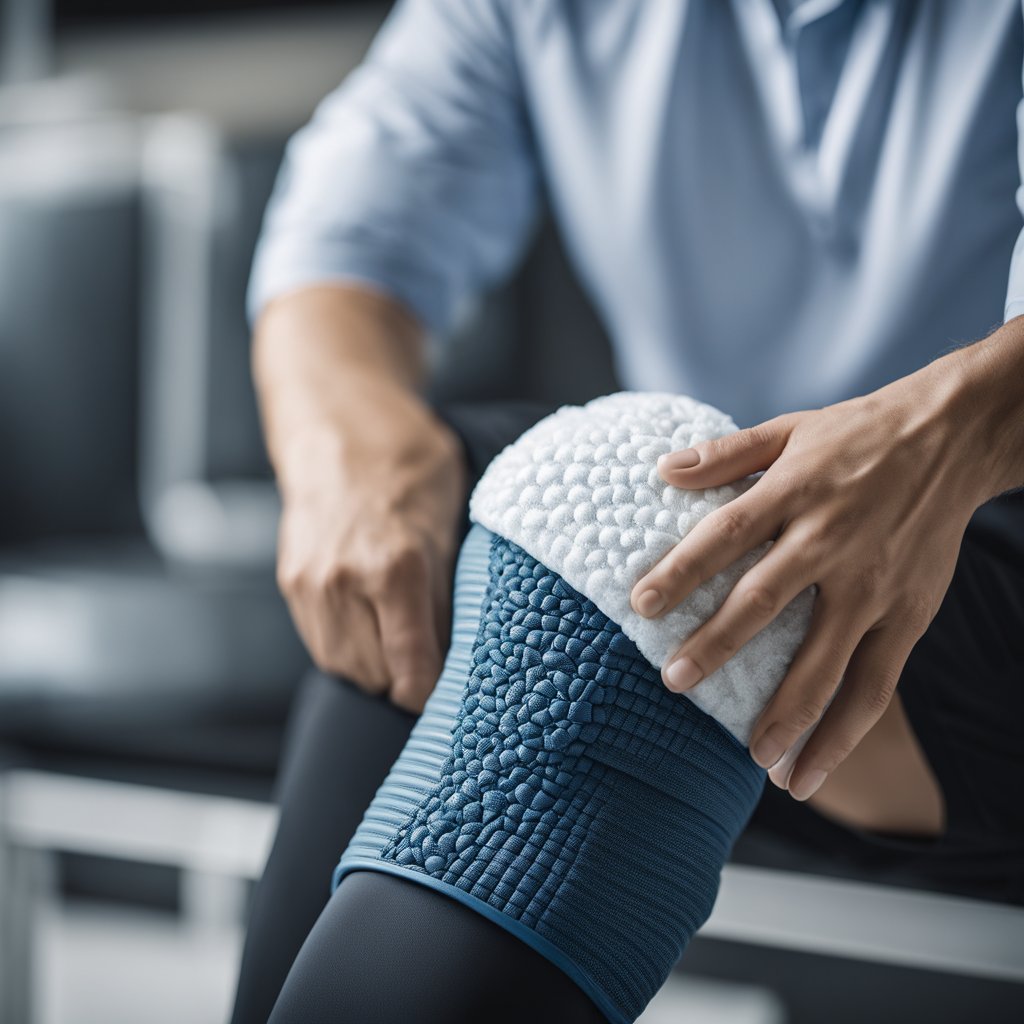In this step-by-step guide, we will show you how to combine cold therapy wraps with other treatments to maximize its effectiveness. Cold therapy wraps are used to reduce pain and inflammation in various parts of the body. By following these steps, you can enhance the benefits of cold therapy and optimize your recovery process.
Step 1: Understand the benefits of cold therapy wrap
Using a cold therapy wrap offers several benefits for healing and recovery. First, it helps reduce swelling by constricting blood vessels and preventing fluid buildup in the injured area. For example, if you sprained your ankle, applying a cold therapy wrap can help minimize the swelling and speed up the healing process. Additionally, a cold therapy wrap helps relieve pain by numbing the area and reducing inflammation. It’s particularly helpful for injuries like muscle strains or joint sprains. Lastly, cold therapy wraps promote healing by increasing blood flow to the injured area, which brings essential nutrients and oxygen to support tissue repair. This can be beneficial for conditions such as tendonitis or post-surgical recovery. Overall, using a cold therapy wrap can be a simple and effective way to manage pain, reduce swelling, and promote healing after an injury.
Step 2: Consult with a healthcare professional
- Schedule an appointment with a healthcare professional to discuss your specific condition and treatment options.
- Inform the healthcare professional about your intention to use a cold therapy wrap and ask for their advice on whether it can be safely combined with other treatments you may be undergoing.
- Be prepared to provide detailed information about your medical history, any medications you are taking, and any previous experiences with cold therapy wraps.
- Follow the recommendations provided by the healthcare professional regarding the use of the cold therapy wrap in conjunction with other treatments to ensure your safety and optimize the effectiveness of your treatment plan.
Step 3: Identify other treatments
In Step 3, we need to identify other treatments that can be combined with the cold therapy wrap. Some options to consider are heat therapy, physical therapy exercises, and medication. Heat therapy can be applied using a hot water bottle, warm compress, or a heating pad to alleviate muscle stiffness and promote blood circulation. Physical therapy exercises can help strengthen muscles and improve flexibility. Examples include gentle stretching exercises, range of motion exercises, and low-impact activities like swimming. Lastly, medication such as over-the-counter pain relievers or prescribed anti-inflammatory drugs can be used to manage pain and reduce inflammation. Remember to consult with a healthcare professional to determine the most suitable combination of treatments for your specific condition.
Step 4: Research the compatibility
To research the compatibility of combining a cold therapy wrap with the identified treatments, gather information from reliable sources, medical professionals, or trusted websites. Consult these resources to determine the effectiveness and safety of using a cold therapy wrap alongside the treatments. This will help you make an informed decision about whether or not to incorporate the cold therapy wrap into your treatment plan.
Step 5: Follow recommended protocols
Ensure that you follow the recommended protocols for each treatment and the cold therapy wrap. This includes specific durations, frequencies, and techniques. For example, you may be advised to apply the cold therapy wrap for 20 minutes, three times a day, using a circular motion. Following these protocols is important to optimize the effectiveness of the treatment and promote a speedy recovery.
Step 6: Schedule treatments
To create a schedule for incorporating the cold therapy wrap with other treatments, consider the recommended waiting periods between each treatment. Start by determining the frequency of each treatment and identify any time constraints that may exist. Next, allocate specific time slots for each treatment throughout the day, ensuring that there is sufficient time for the cold therapy wrap to be applied and removed. Finally, document the schedule in a clear and easy-to-follow format, making sure to include any instructions or guidelines for each treatment.
Step 7: Monitor progress
To regularly monitor your progress and evaluate the effectiveness of combining the cold therapy wrap with other treatments, follow these steps:
- Keep track of any improvements or changes in your symptoms. Note down any reduction in pain, swelling, or discomfort.
- Take regular measurements of the affected area to track changes in size or range of motion.
- Pay attention to any changes in your overall condition, such as increased mobility or improved functionality.
- Discuss your progress with your healthcare provider to get their input and guidance on how to proceed.
By monitoring your progress, you can determine if the cold therapy wrap and other treatments are providing the desired results. This will allow you to make any necessary adjustments or modifications to your treatment plan for optimal recovery.
Step 8: Adjust if necessary
- If you experience any negative effects or find that your progress is not as expected, it is important to consult with your healthcare professional.
- They can assess your situation and provide guidance on whether any adjustments need to be made to your current treatment plan.
- For example, if you are taking medication for a certain condition and are experiencing unwanted side effects, your healthcare professional may recommend adjusting the dosage or switching to a different medication.
- Alternatively, they may suggest additional therapies or lifestyle changes that could help improve your outcomes.
- Remember, your healthcare professional is there to support you and provide the best possible care, so don’t hesitate to reach out to them if you have any concerns or questions.
Optimizing treatment outcomes with combination therapy
In conclusion, combining a cold therapy wrap with other treatments can be a powerful approach for enhancing effectiveness. Throughout this guide, we have emphasized the importance of seeking professional guidance, researching compatibility, and monitoring progress. By following these steps, we can ensure that our combination therapy is safe and optimized for maximum effectiveness. Remember, it is crucial to consult with healthcare professionals to determine the best course of action for your specific condition. Additionally, researching the compatibility of different treatments and monitoring progress will enable us to make informed decisions and tailor our approach accordingly. By implementing these strategies, we can harness the full potential of combining cold therapy wrap with other treatments for optimal results.
Necessary Supplies
Enhancing Cold Therapy Efficacy
Instructions for using the Cold Therapy Wrap
- First, ensure that the cold therapy wrap is properly stored in the freezer prior to use, as this will allow it to reach the desired cold temperature
- When ready to use, remove the cold therapy wrap from the freezer and place it in a clean towel or cloth to act as a barrier between the wrap and your skin
- Apply the wrap to the affected area, gently securing it in place with the provided straps or fasteners. It’s essential to avoid applying the wrap directly to the skin, as it can cause discomfort or even frostbite
- Leave the cold therapy wrap on for the recommended duration, which is typically around 15-20 minutes. It’s important to adhere to the recommended time frame to avoid any potential skin damage
- After the suggested time, remove the cold therapy wrap and allow the area to warm up naturally. You may experience temporary numbness or redness, but this should subside in a short period
- If necessary, the cold therapy wrap can be reapplied after a suitable interval, following the same steps as previously mentioned
- It’s crucial to follow the instructions provided by the manufacturer regarding the frequency of use and any specific precautions or limitations
- If you have any concerns or questions, consult with a healthcare professional before using the cold therapy wrap. They can provide personalized advice based on your specific condition or situation
Frequently Asked Questions about Cold Therapy Wraps
Can a cold therapy wrap be used for chronic pain management?
Yes, a cold therapy wrap can be used for chronic pain management. Cold therapy, also known as cryotherapy, is commonly used to alleviate pain, reduce inflammation, and promote healing. When applied to the affected area, the cold temperature helps to constrict blood vessels, which can reduce swelling and numb the area to provide pain relief. Cold therapy wraps are specifically designed to deliver a controlled and consistent cold temperature to the affected area, making them effective for managing chronic pain. It is important to note that cold therapy should not be applied directly to the skin for an extended period of time to avoid potential damage. Therefore, it is recommended to follow the instructions provided by the manufacturer and consult a healthcare professional for guidance on the appropriate use of cold therapy wraps for chronic pain management.

